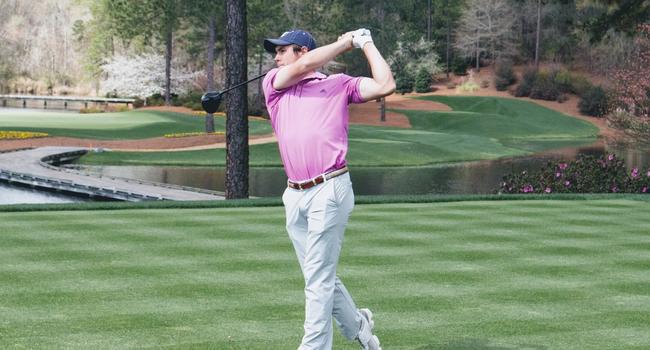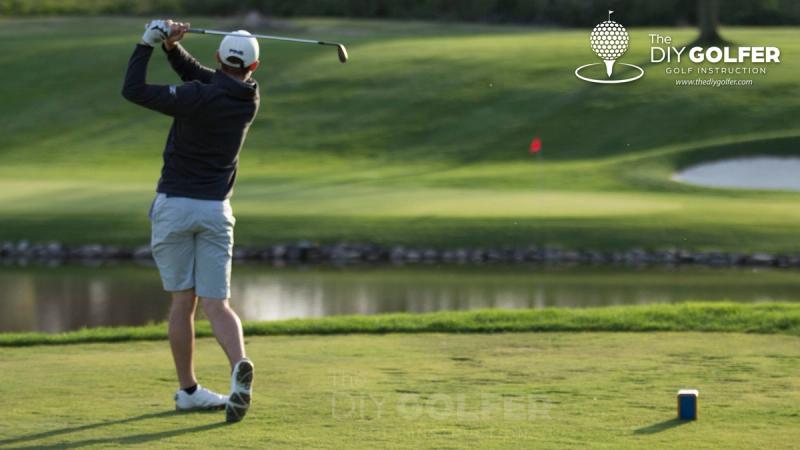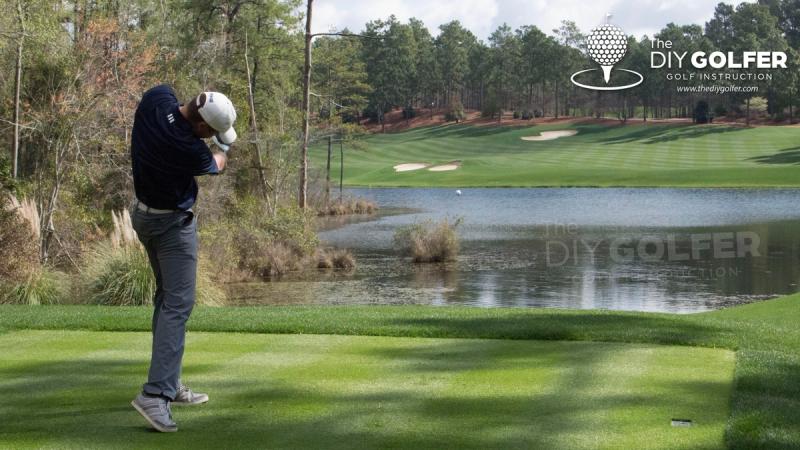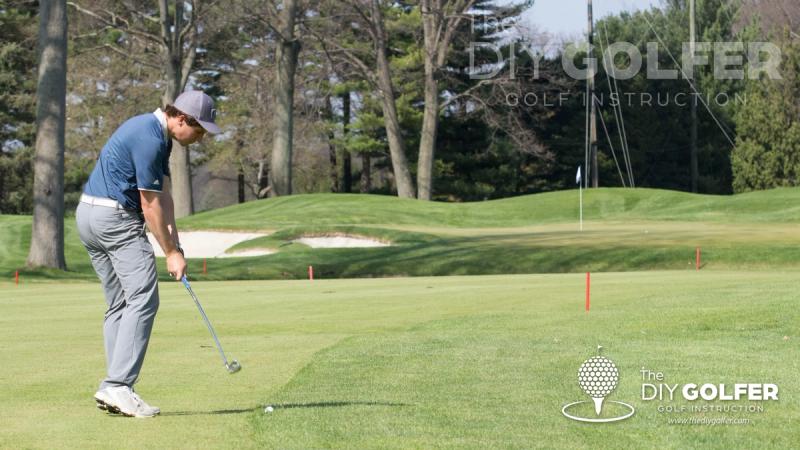Table of Contents

Last updated Nov 03, 2023
Learn the transition and fix your over-the-top golf swing
This post explores the transition portion of the golf swing, and why it is so important to a golfers success.
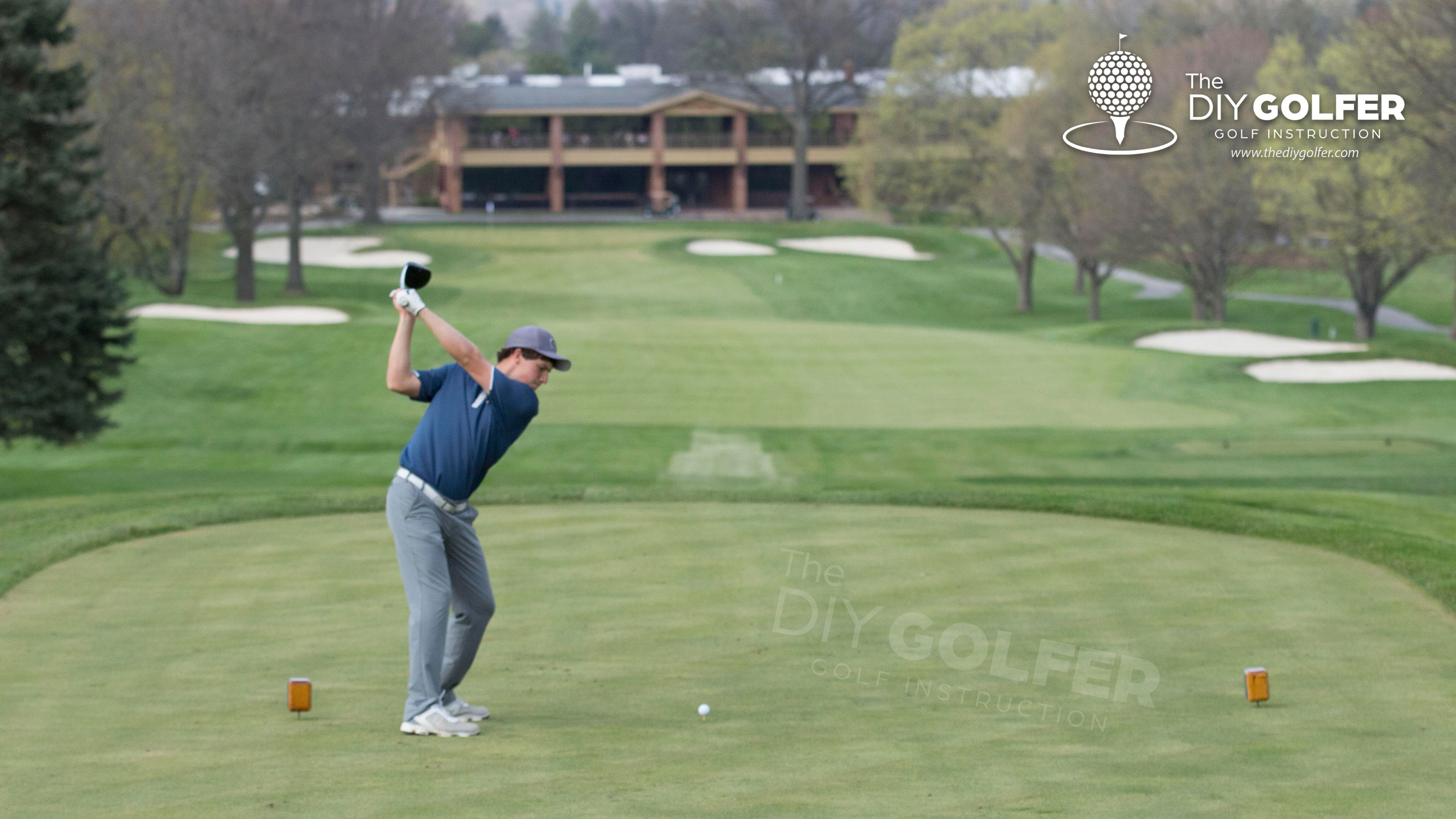

Written By: Zach Gollwitzer
Posted in: Golf Swing Fundamentals
In this chapter, we will be going over what I personally believe to be the most critical component of the golf swing. The transition is the moment which the golf swing switches directions (from backswing to forward swing), but for explanatory purposes, I will be defining it as the P4-P5 interval, or in other words, the top of the backswing to the point in the downswing when the left arm is parallel to the ground. The transition is critical to consistent golf because it is the interval in which all the downswing alignments are established. Further, once the downswing has started, the golfer has no control over the outcome. This may sound ludicrous to some after seeing Tiger Woods stop his swing in the middle of the downswing, or after listening to Jack Nicklaus tell the press how he "redirected" his 1 iron at the top of his golf swing during the 1972 U.S. Open on the 17th hole.
In Search for the Perfect Golf Swing, the authors did experimental tests on professional golfers, trying to figure out at what point in the golf swing the mind has no further control over the outcome. By turning the lights on/off at different intervals during these golfers' swings, the researchers were able to deduce that at some point in the early downswing, the golfer loses complete control of the outcome. When the lights were turned off during the backswing, the golfers would hit poor golf shots as a result of this stimulus change. When the lights were turned off at the beginning of the downswing, the golfers hit perfectly solid golf shots every time. So in the video above of Tiger, it is clear that he had decided to stop his golf swing prior to starting the downswing. You can even hear the announcers perplexed as to how he could possibly stop mid downswing, but the truth is, Tiger had made the decision to stop his swing before starting down.
Why is this phenomenon important?
It is important because from a neurological perspective, it is safe to say that the golf swing is over by the end of the transition. Sure, we can check and analyze positions in the downswing, but it is futile to attempt to change these positions via the use of our primary motor cortex (controls movements). That said, the transition is the last chance a golf gets at correcting any faults that have happened in the backswing. Ever wonder how Jim Furyk can make contact with the golf ball with his backswing?

You can see how he has gone from being dramatically "off plane" to suddenly "on plane" during the transition period. As I often explain in this instructional series, this backswing is not recommended because of the dramatic transition that Furyk has to make in order to return the club to an on plane position. If you have arrived at the top of the swing "on plane" as I have recommended and discussed in the previous chapter, the transition becomes a simple movement that doesn't require much effort at all. During this section, I will be discussing this "simple move" in depth, assuming that you have properly arrived at the top of the backswing in accordance to the previous instructional chapter I have written on the backswing. In addition, I will be discussing how certain faults during the backswing can lead to consequent faults during the transition, and ultimately the downswing (remember, the transition is the defining moment for the remainder of the downswing).
If you have arrived at the top of the golf swing correctly, you should look something like this:

Not everyone can achieve such a beautiful position like Jason day, but there are few keys to check for at the top. Notice how Jason has the (just shy) of 90 degree angle between the right forearm and left forearm (flying wedges), his club has disappeared at the top (as a result of being on plane), and as you can see in the FO view, he has turned against his right leg which acts as a "tilted post." If all these concepts are clear, then we can move on to the transition move. If not, I suggest referencing back to the backswing chapter of the instructional series.
Once you have achieved something to your satisfaction at the top of the backswing, there is a specific sequence of movements which must be made to properly start the downswing.
The Hip Bump
I'm sure you've heard it hundreds of times: "Start the downswing with the lower body." Every time I hear someone say this without elaborating, I cringe, because how on earth is someone supposed to correctly interpret this statement?! I don't know about you, but I can make multiple movements with my lower body, and many of them are insufficient for starting a downswing in golf. The proper way to start the downswing is to laterally slide the hips against the left leg while gradually opening them, all while leaving the upper body alone. Easy enough?
Unfortunately, the golf swing is far too fast to master this sequence of movements in just a few days. Once I finally realized the importance of properly executing this movement (5 years into my golfing endeavor), it took me 4 weeks of practicing it an hour every day before I could even begin to implement it on the golf course. It is far from easy, but crucial to starting the downswing correctly.
I believe many golfers get this wrong because a majority of instructors will attempt to describe this move in terms of "feel," which is largely subjective and an ineffective way to relay information to a golf student.
- "Feel your weight push off your right leg."
- "Feel your weight move to the left side."
- "Feel like your lower body turns and your hands passively drop behind you."
- "Feel like you are swinging out to right field."
These "feels" all sound like they are referring to a different part of the golf swing, but in reality, they are ALL referring to the transition move. How on earth is a golfer lacking knowledge about the bio-mechanics of the golf swing supposed to realize that all these are pointing towards the same thing though?
Although I will never be able to describe this move entirely objectively, I will do my best to explain it in a way which everyone can interpret into their own "feel."
The butt against the wall analogy
A great analogy for understanding this transition move is by imagining that during the transition, your butt is always touching a wall.

Imagine that at the top of the backswing, your right butt cheek is sitting against a short wall (red line). As you make your transition from p4 to p5, your upper body passively pulled by the lower body, which is moving laterally along that wall, while at the same time opening up. You can see that as the golfer laterally shifts the hips, the buttocks touches the wall at different points. At the top, the right butt cheek touches the wall, and as the lateral shift happens, the entire buttocks comes into contact with the wall, eventually opening to where the left buttock is the only portion touching the wall.
Try my transition drill to further understand this movement:

Here is a great golf swing drill that will help you learn how to start the downswing with the lower body properly.
Also, Note that this lateral hip slide is subtle, and does not move outside of the left leg. Just like the right leg acts as a "post" in the backswing, the left leg acts as a "post" in the downswing. When a golfer shifts the weight too far laterally, the left leg must move backwards (southward in this birds eye view) and must straighten to maintain balance. Although this eventually happens at the end of the swing when the golfer stands up into the finish, it should not be happening during the transition. During the transition interval, the hips should be laterally shifting and opening along the wall and into the left leg "post."
All while this is happening, the upper body isn't making any active movements. It is simply staying in the P4 position, and letting this hip movement bring it down "on plane." If the golfer actively moves the upper body during the transition, it will generally cause an "over the top" move, which will prevent the hips from laterally shifting. Instead, they will just spin open. It is key that the hips shift laterally AND circularly during the transition.
The "Over the Top" Move
When the hips lack any lateral movement, and the weight fails to gradually shift to the left side during the transition, this throws the shoulders off plane. You can also say that opening the shoulders causes this "spinning out" movement of the hips. Causality is not important here. What is important is understanding the relationships and realizing the detrimental effects of this "over the top" move.
In its simplest form, the "over the top" move is when the golfer performs his/her downswing in a plane direction that is left of the plane direction (target line) set during address. You can see me demonstrating this in the video below:
The above video is demonstrating the wrong way to start the downswing. Notice how my hips are "spinning out," throwing my right shoulder over the plane established at address. This fault is arguably the most common fault amongst beginning golfers, and there are hundreds of instructional videos on YouTube that attempt to deliver the "cure" for it. Some of these videos offer good advice, but you may become overwhelmed with all the drills that are supposed to cure the OTT move.
Personally, I find many of the drills useless, because they are so far displaced from the actual motion of swinging a golf club that the golfer can't apply it when a real club is put in their hands.
I was watching a video recently where the instructor says that the "root cause" of the OTT move is the "preoccupation with trying to get the club-face to the ball."
Already, I believe this instructor has confused the average golfer, because this is not truly the "root cause" from a bio-mechanical standpoint. This is the root cause from a psychological standpoint, but as we have discussed, describing movements in terms of "feels" is ineffective, as they are subjective to the individual golfer. I cannot reiterate enough--teaching in terms of "feels" is usually ineffective!
In the end, the only proper way to get the lower body transition move correct and cure the "over the top" fault is by practicing it over and over and over. You can do this by holding a club normally, and starting from the top of the swing, or by holding a club against the chest and practicing the move. I have shown this in the video below:
The Left Leg
I have briefly discussed how the hips should laterally shift against the left leg, which acts as a stationary "post" to contain the lateral movement. I wanted to elaborate a bit more on this, and describe the different pressures that should be present in the left leg when this is properly executed.
As the hips laterally shift towards the left leg during the transition, the golfer will notice increased tension in the iliotibial band. At first, this tension will be present at the upper portion of the leg, and as the downswing progresses (past the transition), the tension will move more towards the knee.
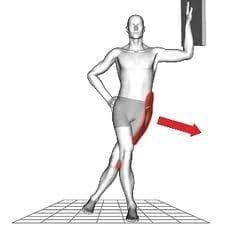
The iliotibial band spans from the knee region up to the hip region, and can be felt through the stretch shown above. When I say "laterally shifting against a stationary left leg post," I simply mean using this muscle to resist letting the weight move outside of the left leg. Hogan did this extremely well:
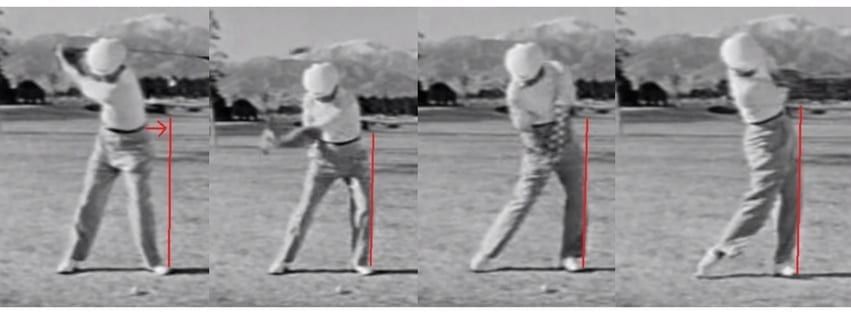
In the sequence above, you can see how during the transition, the hips laterally slide towards the red line, and then throughout the rest of the downswing and post impact, the left leg remains on that red line, acting as a "post" which contains the immense force moving forward to the left side during the downswing. Without this left leg, the weight would keep moving forward and the golfer would fall over.
I have queued up the video above to demonstrate how Manuel De Los Santos executes a golf swing without a left leg! Since he does not have a left leg to "hit against," to avoid falling over towards the target, he has to spin his body. This spinning motion is exactly what happens when a two legged golfer fails to shift the weight to the left side, and causes an over the top motion. Obviously, Manuel has no way of avoiding this over the top motion, and has made necessary alignment adjustments to compensate for this.
Applying the left leg to the transition
Since I have digressed from explaining explicitly the transition portion of the swing, I want to interpret this left leg idea a bit more. The goal of the transition is to shift the hips laterally so that the left leg reaches its stationary "post" position. During the rest of the swing, all the golfer must do is keep it there. Again I have displayed Hogan's swing, but this time, focus in on what the hips are doing in the first two photos. They are laterally shifting and opening, and the hands naturally drop behind Hogan in that "lagging" position.

Rhythm
Thus far, I hope that I have adequately explained what happens during the transition portion of the golf swing. Now, we must talk about rhythm, which is also critical to performing a successful transition.
When I say "rhythm," I am not talking about how fast or slow a golfer swings. I am referring to how fast different parts of the body are moving in relation to one another.
During the transition, if the hips slide and open faster than the upper body and move, the golfer gets "stuck," and has nowhere for the arms to go. If the hips move too slow, the arms can race ahead, and either get over the top, or release too early.
Rhythm is difficult to explain well through text, so it is up to the individual golfer to practice enough to develop this rhythm.
Why the Transition is Important
I couldn't possibly end this post without explaining the bio-mechanical reasoning behind the transition. It turns out, the "hip bump" allows for several things to happen during the downswing.
Steady Center
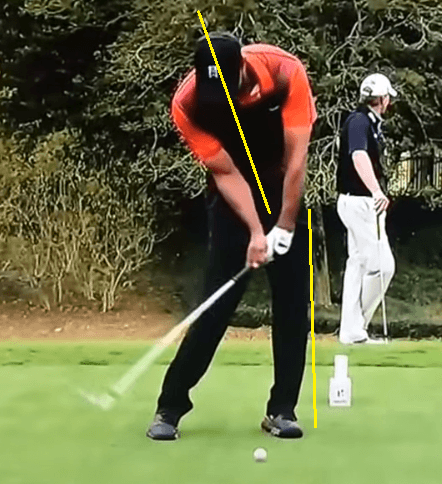
Through the entirety of this instructional material, I have preached about keeping the golf swing "centered." This in effect keeps the low point of the swing arc in a stationary position, and lends to a more consistent golf swing. Without a hip bump during the transition, there would be no way to keep the head centered in the golf swing. It would simply move forward as the weight shifted forward. The hip bump allows the spine to tilt away from the target, which creates space for the hands to travel and a way for the head to stay centered.
In the photo above, notice how the yellow line representing Tiger's spine angle is pointing away from the target, while the weight has moved forward against the left leg "post" represented by the other yellow line. The hip bump has allowed the weight to move towards the left side without moving the golf swing's center (head).
On Plane
In addition to allowing the swing to remain centered, the hip bump allows the right shoulder to travel down the swing plane, which keeps all the forces of the golf swing in alignment:
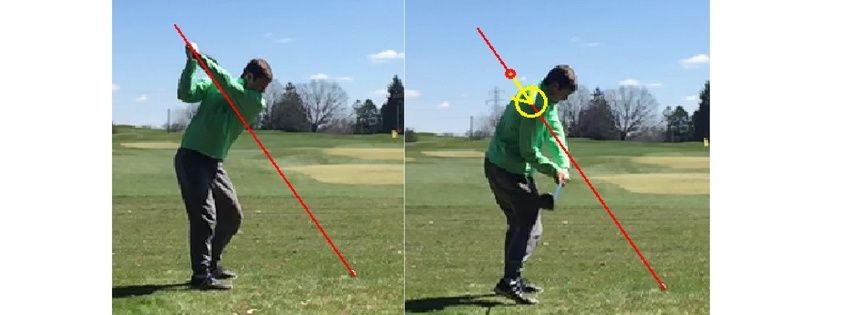
You can see how my right shoulder has moved "down the shoulder plane," which subsequently forces the club-shaft on its own respective plane.
Recap
This entire post has been about one tiny little hip movement, but an important one at that. This hip movement will make or break your golf swing, and I suggest you practice it accordingly. There are several other biomechanical factors at play during the transition, but I chose to leave these trivial movements out of my explanations as to avoid confusion, and direct the reader's attention towards the most important part of the transition.
